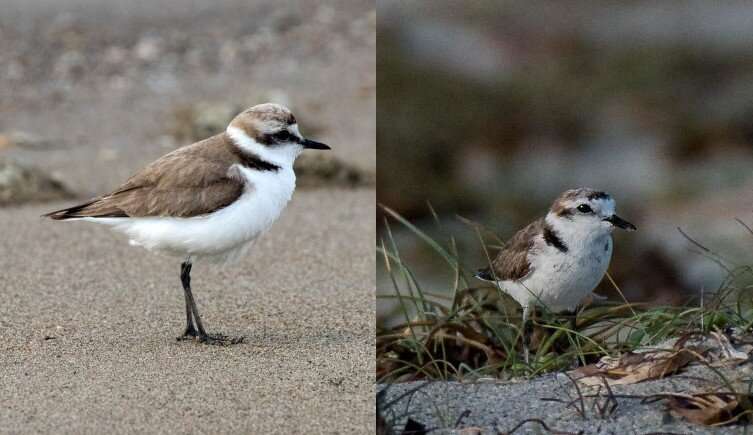This article has been reviewed according to Science X's editorial process and policies. Editors have highlighted the following attributes while ensuring the content's credibility:
fact-checked
trusted source
proofread
Hanuman plover makes a comeback as a species after 86 years

The Hanuman plover, named after a Hindu god, has been reinstated almost a century after being relegated to a subspecies. It is hoped that resurrecting the species will focus conservation attention on at-risk habitats.
In the 1930s, the Hanuman plover, Charadrius seebohmi, was merged with the Kentish plover as both species were considered to be the same. The advent of DNA sequencing has now allowed scientists to confirm subtle differences between the groups that are enough to split them apart once again.
The researchers hope that by resurrecting the species, which lives in Sri Lanka and southern India, conservation funding will be used to help protect the area's threatened wetlands. These habitats are highly biodiverse and provide important overwintering sites for migrating birds.
Dr. Alex Bond, who co-authored the study and is Principal Curator and Curator in Charge of Birds at the Museum, says, "While we don't know if the Hanuman plover is threatened at the moment, it lives in an area which has one of the highest human population densities on the planet."
"Having a name attached to these birds means it is easier for policymakers and politicians to notice these plovers and take any steps needed to help them."
The findings of the study were published in the journal Ibis.
The problem with plovers
Plovers are a family of shorebirds that live all over the world, except for the very poles. They feed on invertebrates, but otherwise have a range of different habitats and lifestyles.
One of the most widely distributed species is the Kentish plover, which despite its title no longer lives in the English county which gives it its name. At one point, the species was thought to inhabit an area stretching across several continents from South America across to Europe and southeast Asia.
While populations in different parts of the world were split into different subspecies, they were all considered closely related enough that they all kept the scientific name Charadrius alexandrinus.
"The Kentish plover reflects a general trend of lumping different taxa together, particularly in birds, in the mid to late twentieth century," Alex explains. "In the past 20 years the move has been to split these up as we've recognized that what was thought to be one species can actually be several different ones."
One of the largest changes came in 2009, when a paper comparing Kentish plovers living in Europe and Asia to those in the Americas was released. Genetic comparisons of the two groups revealed that their populations were more different from one another than between some other plover species.
This led to the snowy plover being resurrected, sparking investigations of other birds that could have the potential to become species in their own right. One promising candidate was another subspecies of the Kentish plover, known as C. a. seebohmi.
How was the Hanuman plover resurrected?
To assess whether the Hanuman plover was more than a subspecies, the researchers took measurements and samples from wild birds, as well as specimens held in the world's museums.
They found that these birds tended to have smaller wings, tails and beaks than the Kentish plover, as well as different plumage. While the Kentish plover tends to have black legs in both sexes, the Hanuman plover has dark gray legs, while males have a black stripe across their forehead that C. alexandrinus doesn't.
Observations of wild birds also showed that Hanuman plover molt differently than the Kentish plover. The Asian birds molt much earlier in the year, and molt different feathers before the breeding season, than their relative.
Even stronger evidence that these birds were two different species was found in their genetics, which suggested they had split apart around 1.2 million years ago. At the time, levels of carbon dioxide in the atmosphere were decreasing, which caused changes in the timing of Ice Ages.
The researchers suggest that this event, known as the Mid-Pleistocene Transition, might have been responsible for causing the two species to diverge as a result of the environmental impacts it caused, such as sea level changes.
Collectively, the evidence was enough for the team to say that the species should be resurrected.
"Over a century ago these birds were considered to be their own species, so it's not that these plovers have changed," Alex says. "Instead, it's our understanding of what a species is, and how much variation is suitable to differentiate one, that is different."
"It's this, along with the advent of genetic techniques, that have allowed us to tease these two species apart."
While the Latin name of the restored species was decided by scientific naming rules, the researchers were able to pick a new common name. They chose to name the species after the Hindu god Hanuman, who according to legend built a bridge between southern India and Sri Lanka.
Future research could help to reveal more about this enigmatic plover now it has been identified as a species in its own right.
More information: Jude Janitha Niroshan et al, Systematic revision of the 'diminutive' Kentish Plover (Charadriidae: Charadrius ) with the resurrection of Charadrius seebohmi based on phenotypic and genetic analyses, Ibis (2023). DOI: 10.1111/ibi.13220
Provided by Natural History Museum
This story is republished courtesy of Natural History Museum. Read the original story here















